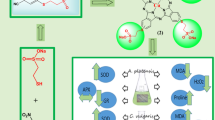Abstract
The effect of the organometallic compounds containing lead, (C6H5)3PbCl, and tin, (C6H5)3SnCl, on Chlorella green algae photosystem II was studied. Suspension of the algae treated with (C6H5)3SnCl at concentrations of 1.0 and 4.0 μmol dm−3 for 22 h revealed a decrease in most physiological parameters studied, particularly in decasecond component of delayed chlorophyll luminescence, photosynthetic electron transport rate and diluted oxygen concentration, which implies an inhibition of photosynthetic electron transport as well as oxygen evolving system. On the other hand, (C6H5)3PbCl caused stronger inhibition than (C6H5)3SnCl, particularly in the higher concentration.


Similar content being viewed by others
Notes
PPFD—photosynthetic photon flux density.
References
Berden-Zrimec M, Drinovec L, Zrimec A, Tišler T (2007) Delayed fluorescence in algal growth inhibition tests. Cent Eur J Biol 2:169–181
Bilgrami KS, Kumar S (1997) Effects of copper, lead and zinc on phytoplankton growth. Biol Plant 39:315–317
Boucher N, Carpentier R (1999) Hg2+, Cu2+ and Pb2+-induced changes in Photosystem II photochemical yield and energy storage in isolated thylakoid membranes: A study using simultaneous fluorescence and photoacoustic measurements. Photosynth Res 59:167–174
Danilov RA, Ekelund NGA (2001) Effects of Cu2+, Ni2+, Pb2+, Zn2+ and pentachlorophenol on photosynthesis and motility in Chlamydomonas reinhardtii in short-term exposure experiments. BMC Ecol 1. http://www.biomedcentral.com/1472-6785/1/1, Accessed 26 June 2009
Devlin RM, Murkowski AJ, Zbieć II, Karczmarczyk S, Skórska EM (1983) Influence of buthidazole, diuron and atrazine on some light reactions of photosynthesis. Weed Sci 31:879–883
El Khachia NE, O’Mongain E, Collins A (2008) Temporal characteristics of chlorophyll fluorescence quenching and dissolved oxygen concentration as indicators of photosynthetic activity in Chlorella emersonii. Photosynthetica 46:79–83
Fargasova A (1994) A comparative study of the toxicity and inhibitory effects of inorganic tin compounds on various biological subjects. Biologia C49:307–311
Fargasova A, Kizlink J (1996) Effect of organotin compounds on the growth of the freshwater alga Scenedesmus quadricauda. Ecotoxicol Environ Saf 34:156–159
Krupa Z, Baszyński T (1995) Some aspects of heavy metals toxicity towards photosynthetic apparatus—direct and indirect effects on light and dark reactions. Acta Physiol Plant 17:177–190
Lamaia C, Kruatrachuea M, Pokethitiyook P, Upatham ES, Soonthornsarathool V (2005) Toxicity and accumulation of lead and cadmium in the filamentous green alga Cladophora fracta. A laboratory study. Sci Asia 31:121–127
Lewis LA, McCourt RM (2004) Green algae and the origin of land plants. Am J Bot 91:1535–1556
Memon AR, Aktoprakligil D, Oezdemir A, Vertii A (2001) Heavy metal accumulation and detoxification mechanisms in plants. Turk J Bot 25:111–121
Mohammed M, Markert B (2005) Toxicity of heavy metals on Scenedesmus quadriccauda (Turp) de Brébisson in batch cultures. Environ Sci Poll Res 13:98–104
Murkowski A (2002) Application of luminescence methods in research on responses of crop plants to some stress factors. Acta Agrophys 61:3–158
Murkowski A, Skórska E (2008) Comparison of phytotoxicity of lead and tin organic compounds by means of luminescence methods. Acta Agrophys 11:131–140
Olivares E (2003) The effect of lead on the phytochemistry of Tithonia diversifolia exposed to roadside automotive pollution or grown in pots of Pb-supplemented soil. Braz J Plant Physiol 15:149–158
Pawlik-Skowrońska B, Kaczorowska R, Skowroński T (1997) The impact of inorganic tin on the planktonic cyanobacterium Synechocystis aquatilis: the effect of pH and humic acid. Environ Pollut 97:65–69
Poskuta JW, Parys E, Romanowska E (1996) Toxicity of lead to photosynthesis, accumulation of chlorophyll, respiration and growth of Chlorella pyrenoidosa protective role of dark respiration. Acta Physiol Plant 18:165–171
Przestalski S, Sarapuk J, Kleszczyńska H, Gabrielska J, Hładyszowski J, Trela Z, Kuczera J (2000) Influence of amphiphilic compounds on membranes. Acta Biochim Pol 47:627–638
Rutherford AW, Inoue Y (1984) Oscillation of the light luminescence from PSII: recombination of S2QB− and S3QB−. FEBS Lett 165:165–170
Schreiber U, Bilger W, Neubauer C (1994) Chlorophyll fluorescence as a nonintrusive indicator for rapid assessment of in vivo photosynthesis. In: Schulze ED, Caldwell MM (eds) Ecophysiology of photosynthesis, vol 100. Springer, Berlin, pp 49–70
Skórska E, Swarcewicz M (2006) Comparison of some adjuvants efficacy with Azoprim and Buramet using chlorophyll fluorescence. Comm Appl Biol Sci Ghent Univ 71:141–146
Acknowledgement
Authors wish to thank Professor Janina Gabrielska from the Department of Physics and Biophysics of the Wrocław University of Environmental and Life Sciences for the samples of the metal organic compounds.
Author information
Authors and Affiliations
Corresponding author
Rights and permissions
About this article
Cite this article
Murkowski, A., Skórska, E. Effect of (C6H5)3PbCl and (C6H5)3SnCl on Delayed Luminescence Intensity, Evolving Oxygen and Electron Transport Rate in Photosystem II of Chlorella vulgaris . Bull Environ Contam Toxicol 84, 157–160 (2010). https://doi.org/10.1007/s00128-009-9880-8
Received:
Accepted:
Published:
Issue Date:
DOI: https://doi.org/10.1007/s00128-009-9880-8




